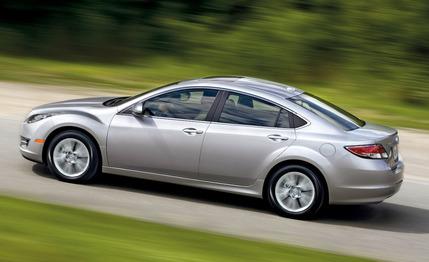 Short Take Road Test
Short Take Road Test

Mazda made a few compromises when it redesigned the 6 for 2009, replacing the smaller and nimbler original with a bigger and slightly softer sedan aimed more at big, soft Americans. We’ve found that the new car retains a good bit of its enthusiast cred, despite its extra size and heft, but as is typical for most buyers in the U.S. mid-size-sedan market, almost two-thirds of second-gen 6 sales thus far have been four-cylinder models backed by a five-speed automatic transmission. Only nine percent have opted for the four-cylinder, six-speed-manual combo, with 28 percent going for the 6 s and its less-fuel-efficient 272-hp V-6 and standard six-speed auto. Why buy a sporty family sedan with an automatic when a manual is available, you ask? The same question crossed our mind, so we hit the road with a slushbox-equipped 6 i to see what buyers are trading for their $900.
The 6 i gets a lively 2.5-liter four—making 170-hp and 167 lb-ft—in place of the 2.3-liter engine from last year, and we’ve already sampled a manual-equipped version. Whereas that first 6 i was a Grand Touring model, this time we tested a less Grand and nearly three-grand-cheaper Touring model. Plain Touring models (be they motivated by i - or s -spec engines) come standard with cloth seats instead of the Grand Touring’s leather, although ours was equipped with the Convenience package that includes leather-accented thrones. We were fine with the leather part of that equation, but the cloth left something to be desired; it’s a black-on-black zebra pattern that would be more at home on a couch in a mirrored-wall, white-carpeted living room.
The $1610 Convenience package also includes dual-zone automatic climate control, automatic xenon headlights, a blind-spot monitoring system, Bluetooth, rain-sensing wipers, and something called Welcome Lighting. Our tester was also equipped with the Moonroof & Bose package, which bundles a hole in the roof with upgraded audio and Sirius satellite, for $1760. With the two packages being the only options added to the base price of $23,275, the sticker totaled an acceptable $26,645.
What We Knew
Rather than force you to click all the way over to our review of the manual-equipped 6 i, we offer a summary of our opinion: The car continues to have a sporty on-road character, although it’s not as involving as the previous model. Steering is Mazda-trademark communicative, with good weight and linearity. The interior has a clean look that’s higher on the handsome scale than that of the Camry and much less button-laden than the Accord’s. Exterior styling is distinctive, from the last-generation 6 as well as from the competition, and does a decent job of imbuing the 6 with some RX-8–ish front-end character.
End Transmission
Trading up to the automatic cog swapper can be one of those necessary compromises buyers make, for convenience in stop-and-go traffic, pure laziness, or fear of the three-pedal ballet we here at C/D so dearly love. The 6 i ’s automatic—like nearly every decent auto these days—offers manumatic shifting. Driver-induced shifts are enacted solely through the console shifter, as there are no wheel-mounted paddles. In automatic mode, the transmission did its best to keep the four-banger quiet, although its tone can get a bit annoying above three grand. Selecting your own gear can bring on more noise, but we were willing to tolerate the additional sound in exchange for control.
The Upshot of a Lost Gear and Pedal
Performance seekers often lament the time lost in the 0-to-60 sprint when opting for an automatic, but that’s not the case with the 6 i . In our testing, the auto-equipped car beat the manual version all the way to 80 mph, with the manual then taking the accelerative lead. The auto’s time of 7.9 seconds to 60 mph is 0.3 second quicker than with the stick shift, mainly because the auto’s five ratios are spaced to allow the run with only one upshift, whereas the six-speed manual needed two. Automatic-equipped four-cylinder models are also supposed to get better fuel mileage, according to the EPA—21/30 mpg versus 20/29—although we saw 21 mpg with our automatic tester and 23 mpg with the manual. Apparently, our mileage does vary.
The 6 i automatic posted much better braking results than the 6 i manual, managing a stop from 70 mph in 169 feet, compared with the longish 189 of the earlier car, with none of the manual’s nonuniform ABS response.
Although the 6’s maturation has brought its fair share of compromises, it’s at least nice to know that opting for an automatic transmission doesn’t necessarily kill the fun.